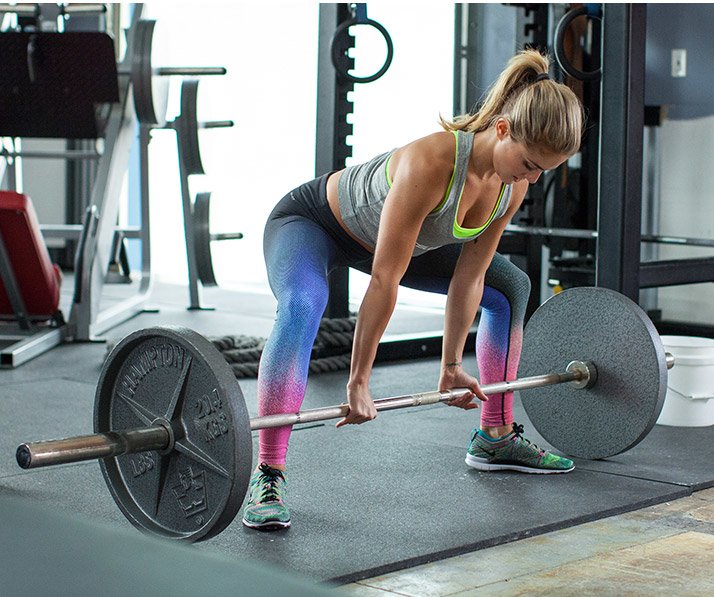
5 Ways To Burn More Fat In Every Workout
The temperature is rising, but it's not too late to cut for your summer beach bod. Use these next-level methods and our printable program to turn your ordinary gym time into a funeral for fat!
Main Page | Burn More Fat in Every Workout | Accelerate Your Fat Loss
Ace Your Summer Shred | Up Your Fat-Loss Supplement Game
Ready or not, it's skin-baring season. If what you see in the mirror makes you nervous, you're far from alone. But a full 90-day makeover isn't going to cut it now, unless you were thinking of getting your beach body in time for football season. No, you're looking for something that delivers faster results is less time.
Condensed, but intense.
Those three words are the perfect description of your ideal session if you're trying to lose as much fat as possible over the next few weeks. The ordinary way of doing things—hours in the gym, fixating on "detail work"—isn't going to cut it anymore. You need to upgrade from ordinary to extraordinary, identifying the most important training factors to amp up in your current workout in order to create a drastic uptick in calorie burn.
Any of the five techniques below will weave well into your current program, allowing you to accelerate your shred. Better yet, you can use the free downloadable training plan at the end of this article to incorporate all of the points and eliminate any guesswork!
Ordinary Do lots of isolation work
Extraordinary Focus on big movements
We get it: There may be nothing more satisfying than hitting a few flyes at the end of a heavy chest day. But a program that's heavily reliant on these types of single-joint moves is far from optimal for fat-burning.

Multijoint exercises should form the foundation of your training, and for good reason: They engage maximum muscle tissue, boost the amount of weight you can lift, increase the calories you expend, and raise your metabolism. They've also been shown to better trigger the release of favorable anabolic hormones like testosterone and growth hormone, both of which have a tremendous effect on muscle growth and fat loss.
"When I'm in a leaning-out phase for a photo shoot, I change my training plan to incorporate more multijoint exercises," says Canadian fitness model and Cellucor athlete Jay Zuccato. "These exercises target multiple muscle groups and burn more calories than isolation movements. That helps you get lean more quickly!"
The Summer Shred workout at the end of this article limits isolation work to 1-2 exercises per body part per session, and only after your heavier, more metabolic work has been completed. That's a good model to follow, period.
Ordinary Use lighter weight for more reps
Extraordinary Use heavier weights with shorter rest periods
Reducing weight loads and increasing reps is typical—almost instinctual—when trying to lean out. The rationale goes that if you're performing more reps, you're doing more work and burning more total calories during your workout.
Here's the problem: Going light doesn't build muscle optimally, and it also takes a lot longer. Research shows that training with heavier weight—somewhere around your 6-rep max—helps raise your metabolism higher and for longer than using lighter weight loads.1
Furthermore, researchers from the College of New Jersey (Ewing) reported that when men bench pressed with just 30 seconds of rest between sets, they burned significantly more calories during the workout than when they rested 3 minutes.2
To get the best of both worlds, select a weight load you can handle safely for 8-10 reps on your first set (after warm-ups) with the knowledge that the decreased rest will put you around your 6-rep max (6RM) by your second or third set.
Ordinary Increase workout length
Extraordinary Get more out of each set
Those eyeing a fat-loss plan have long resigned themselves to the idea they have to spend more time in the gym to burn those extra calories, because it takes extra work to burn off stubborn body fat. However, athletes who compete in fitness and physique often find better success by including techniques that lengthen the time under tension or extend a set past failure.
This way, you increase the amount of work you do without extending the length of your workout by much. That ultimately means the muscle is working harder, elevating your heart rate and burning more calories.

These four classic techniques remain the go-tos for extending sets:
- Supersets: Do two different movements back to back with no rest in between segments. Those exercises can be for the same muscle group or opposing ones.
- Dropsets: Once you reach muscle failure on a given movement, reduce the weight by about 25 percent and immediately resume the set to a second point of muscle failure.
- Rest-pause: Do a set short of muscle failure, rest 15-20 seconds, then get another few reps, rest again, and get another few. For example, with your 6RM, you do 3-4 reps, rest, do 3-4 more reps, rest again, then perform 3-4 more reps. That's 9-12 reps with your 6RM!
- Cluster sets: Cluster sets are similar to rest-pause, but are done for time. Choose your approximate 12RM weight of an exercise, but do just 5 reps, rest 15-20 seconds, and repeat this work-rest sequence for a total time, such as 4 minutes.
Sometimes, it's a combination of techniques that works best. "Whenever I diet for a shoot, my strength tends to slowly decrease as I get leaner," says Zuccato. "One way to still hit your target rep ranges in this situation is to use rest-pause and a dropset. For example, if my goal is to hit 12 reps on all my sets, but I can do only 8, I'll instead start with rest-pause, and then finish the last 4 with a dropset to reach my target. I usually rest for 10-15 seconds."
There's a good reason to steer away from longer workouts when you're reducing calories: Cortisol, a catabolic hormone, can rise quickly when you put your body under stress for a lengthy period of time, and that can be counterproductive to your training efforts. Work hard with weights for about 60 minutes, and you'll be better off than if had you worked out for 90!

Ordinary Sit on your duff between sets
Extraordinary Intensify your rest periods
Are your glutes attached to a bench during your rest periods? That may be helpful when maximum strength is the goal, but not when you're looking to burn fat.
Rather than recovering like normal, try density-training or cardio-acceleration techniques instead. Between sets of chest, for example, you could be skipping rope or performing simple movements that incorporate your legs, like mountain climbers, for 30- to 60-second bouts. Simply choose movements that don't recruit the target of your working sets (chest, in the bench example), so it will have the chance to recover.
As with set-extending techniques, the goal here is to increase the amount of work you do in the same time period. Any conditioning deficiencies you have will show initially, but you'll overcome those over time.
"For someone who is already in great shape and wants to kick their results up a notch and see a visible change, I'd definitely add cardio bursts between sets during weight training," says trainer and Cellucor athlete Jen Jewell. "I do these often in my training when I'm short on time and need to pack in some quick cardio with weights, or in addition to my regular cardio workouts when I'm leaning out for a shoot or show.
"I add 30-60 seconds of cardio 'bursts' between every set of every exercise during my strength-training workouts," she continues. "This adds up to some serious fat burning, and as a bonus, improves my endurance, too!"
Some of Jen's favorite movements to plug in as "cardio bursts" include:
- Push-up to side plank
- Mountain climber
- Mountain climber with push-up
- Burpee
- Jumping rope
- Plank with punch
Ordinary Endure long, slow cardio
Extraordinary Perform fast, fun cardio
Until a few years back, you'd see precontest bodybuilders sitting on stationary bikes and cycling for upward of two hours a day to burn off body fat at a fairly low but constant intensity. That was in addition to their weight workouts. And it made for very long days in the gym.
For a while now, exercise research has suggested there's a far better way to maximize fat loss. You've probably heard of high-intensity interval training (HIIT) by now, and it's worth remembering, because it's the most time-efficient method you'll find for burning body fat.

Consider a study published in the International Journal of Obesity that compared individuals who did steady-state cardio for 40 minutes to those who completed just 20 minutes of HIIT training, both for three times a week.3 The HIIT group lost a significant amount of body weight and body fat compared to the steady-state group. The steady-state group actually saw a 1 pound increase in fat mass!
However, interval training on the same kind of cardio equipment can get redundant. "Use different forms of conditioning to trim down," suggests Jewell. "A lot of people get stuck in the routine of doing the same 1-2 forms of cardio, and after a while, their body grows accustomed to it. You can also stop challenging yourself as much and end up just going through the motions."
For an example of how this looks in action, check out Jen's workouts in "4 Fun Cures for the Cardio Blues."
"I challenge myself to not do the same type of cardio two days in a row, and that means at least 3-4 different kinds a week. I'll do intervals on the StepMill, intervals on the Jacob's ladder, treadmill work, battling ropes, running bleachers or stairs outside—whatever keeps me out of a cardio rut," Jewell adds. "Looking for new ways to stimulate your body—and mind—allows you to achieve better results."
Put It All Together
Put these principles into action, and you'll see progress on any program. But why do just any program when you can jump right into one where the variables are all dialed in for you? We've designed a free five-days-a-week program that will help you redefine "defined" if you stick to it as written for the next 4-6 weeks. Selfies, anyone?


